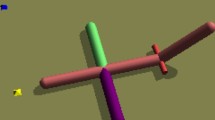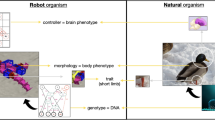Abstract
Evolutionary developmental biology, evo-devo, emerged to integrate evolution and development in the 1980s, in which evolution is conceptualized as heritable changes in development. Recently, the field is moving to a new synthesis: ecological evolutionary developmental biology, eco-evo-devo. We believe that artificial life (ALife) approach will provide new insights into the field, and also contribute to the field of robotics through the emergence perspective and the constructive methodology. This paper explores the potential of such an artificial life approach based on the evolution of virtual creatures by presenting our ongoing studies with three models: (1) metamorphosis model, (2) exaptation model and (3) Prey-predator model.








Similar content being viewed by others
References
Arthur W (2011) Evolution: a developmental approach. Wiley, New York
Moczek AP et al (2015) The significance and scope of evolutionary developmental biology: a vision for the 21st century. Evol Dev 17(3):198–219
Gilbert SF, Epel D (2009) Ecological developmental biology: integrating epigenetics, medicine, and evolution. Sinauer
Abouheif E, Favé M-J, Ibarrarán-Viniegra AS, Lesoway MP, Rafiqi AM, Rajakumar R (2014) Eco-evo-devo: the time has come. Ecological genomics: ecology and the evolution of genes and genomes. Springer, Netherlands, pp 107–125
Müller GB (2007) Evo-devo: extending the evolutionary synthesis. Nat Rev Genet 8(12):943–949
Sims K (1994) Evolving virtual creatures. In: Proceedings of the 21st annual conference on computer graphics and interactive techniques (SIGGRAPH 94), pp 15–22
Sims K (1994) Evolving 3D morphology and behavior by competition. In: Proceedings of artificial life IV, pp 28–39
Gould SJ, Vrba ES (1982) Exaptation: a missing term in the science of form. Paleobiology 8(1):4–15
Stanley KO, Miikkulainen R (2003) A taxonomy for artificial embryogeny. Artif Life 9(2):93–130
Groombridge B (ed) (1992) Global biodiversity: status of the earth’s living resources, a report compiled by the world conservation monitoring centre. Chapman & Hall, London
Joachimczak M, Suzuki R, Arita T (in press) Artificial metamorphosis: evolutionary design of transforming, Soft-bodied Robots. Artificial Life, MIT Press, Cambridge
Joachimczak M, Suzuki R, Arita T (2015) Improving evolvability of morphologies and controllers of developmental soft-bodied robots with novelty search. Front Robot AI Comput Intell 2:33
Stanley KO, Miikkulainen R (2002) Evolving neural networks through augmenting topologies. Evol Comput 10(2):99–127
Pievani T, Serrelli E (2011) Exaptation in human evolution: how to test adaptive vs exaptive evolutionary hypotheses. Journal of Anthropological Sciences 89:9–23
Asakura A, Suzuki R, Arita T (2015) Evolving 3D virtual creatures through exaptation triggered by environmental change. Artif Life Robot 20(3):244–250
Pilat ML, Jacob C (2008) Creature academy: a system for virtual creature evolution. In: Proceedings of the IEEE congress on evolutionary computation (CEC 2008), pp 3289–3297
Kokko H, Lopez-Sepulcre A (2007) The ecogenetic link between demography and evolution: can we bridge the gap between theory and data? Ecol Lett 10(9):773–782
Post DM, Palkovacs EP (2009) Eco-evolutionary feedbacks in community and ecosystem ecology: interactions between the ecological theatre and the evolutionary play. Philos Trans R Soc B 364(1523):1629–1640
Ito T, Pilat ML, Suzuki R, Arita T (in press) Population and evolutionary dynamics based on predator-prey relationship in 3D physical simulation. Artif Life. doi:10.7551/978-0-262-32621-6-ch018
Ito T, Pilat ML, Suzuki R, Arita T (2015) Evolutionary change precedes extinction in eco-evolutionary dynamics based on a 3D virtual predator-prey system. In: Proceedings of the 13th European conference on artificial life, p 639
Acknowledgments
This work was supported by the Japan Society for the Promotion of Science (JSPS) through JSPS KAKENHI Grant Numbers 26-04349 and 26-10516, and also by the JSPS Fellowship for Foreign Researchers.
Author information
Authors and Affiliations
Corresponding author
About this article
Cite this article
Arita, T., Joachimczak, M., Ito, T. et al. ALife approach to eco-evo-devo using evolution of virtual creatures. Artif Life Robotics 21, 141–148 (2016). https://doi.org/10.1007/s10015-016-0278-5
Received:
Accepted:
Published:
Issue Date:
DOI: https://doi.org/10.1007/s10015-016-0278-5




